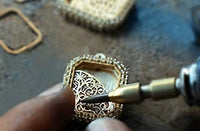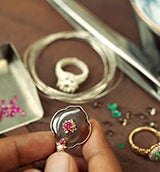"Hang my seal around your neck, wear my seal on your finger"
- Song of Solomon
 A still from the movie , Queen Victoria is shown handing this locket over to her controversial Indian attendant Abdul Karim, as a memory of her.
A still from the movie , Queen Victoria is shown handing this locket over to her controversial Indian attendant Abdul Karim, as a memory of her.
source: Royal Collection Trust
A picture of the original locket - Circular gold locket set with pearls, emeralds and diamonds containing a miniature of Queen Victoria which is based on a photograph by Hills & Saunders of c.1865 (RCIN 2105807). The locket is engraved on the reverse with the inscription:
“TO VICTORIA ALBERTA GRANT SUTTIE / from / VICTORIA R / 16th Nov r. 1867.”

A heart shaped photo pendant from 1940s, source:www.pexels.com
The desire to hold a keepsake or remembrance of our loved ones goes back to the earliest days of civilisation. In the Biblical Song of Solomon, written over 3,000 years ago,quoted above, the writer desires to have his seal worn as a keepsake around his lover's neck.
From the time of the Renaissance, 800 years ago, when the art of portraiture became more widely established, portraits began to be incorporated into lockets which were embellished with the most precious jewels and decoration.

A 16th century locket portrait of King James I, by Nicholas Hlliard.
This locket was gifted to Thomas Lyte by King James I and is known as the Lyte Jewel
(By courtesy of the British Museum).
The below cited love token is believed to be one of a pair probably commissioned by the Prince of Wales for the woman he adored, but was forbidden to marry. It dates back to the 1800s.

source: christies
THE MARIA FITZHERBERT JEWEL
A diamond-glazed locket containing a portrait of King GEORGE IV when Prince Of Wales (1762-1830)
The oval locket's cover centred with a portrait and surrounded by 18 rose-cut diamonds, a rose-cut diamond-set suspension loop was commissioned by King George IV and gifted to Maria Fitzherbert, née Smythe. It was auctioned for £341,000 on 6 July 2017 at Christie’s in London.
“The first known pieces of photographic jewellery were from the 1840s and incorporated daguerreotype portraits.”


Left - Large gilt locket containing a daguerreotype of a young man, with gold decoration, and a manuscript reads 'To my beloved and affectionate wife, sincerely praying we meet in heaven" Dated back to 1840s-1850s Source: National Museums Scotland, History of Science, Howarth-Loomes Collection, Museum)
Right - Watch locket, seed pearl surround, Daguerreotype of a gentleman, lady on the reverse, 1855 (ca) Private collection of Larry West, From the book: Tokens of Affection and Regard
source: sotheby's
A jewelled 9ct gold and enamel locket, English, circa 1860
An oval locket, the front applied with rose diamonds and rubies forming the initials 'B&C' below a ducal coronet, on black enamel ground, opening to reveal a hand-coloured photograph on paper of Richard Temple-Nugent-Brydges-Chandos-Grenville, 3rd Duke of Buckingham and Chandos (1823-1889) within a gold frame, suspension loop.

source: Royal Collection Trust
Queen Victoria's Locket c. 1861
Gold locket with onyx, diamond and enamel design, with hair and photograph contained inside
A small gold memorial locket, set with central oval onyx, black on white, with diamond star set in plain gold border with blue enamel inscription, 'Die reine Seele schwingt sich auf zu Gott', roughly translated as 'The pure soul flies up above to the Lord'. Opens to reveal hair on one side and photograph of Prince Albert on the other, both under glass.
This was one of a group of jewels placed in the ‘Albert Room’ at Windsor Castle after the Queen's death in 1901. This was the room in which Prince Albert had died in 1861 and the
Queen left instructions for a specific list of personal jewellery to be placed there and not passed on in the family.
*It was Queen Victoria who successfully increased the acceptance of wearing photographic jewellery by wearing, collecting, and exhibiting a variety of jewellery incorporating photographs of her late husband, Prince Albert. The Queen was instrumental in making it a fashion statement that many embraced, first in the United Kingdom, with Europe and North America following thereafter.”
“In Jane Austen’s “Sense and Sensibility”, a marriage proposal is assumed when a miniature portrait and a lock of hair are referenced.”

Locket titled "Somebody's Luggage" 1862 (ca)
Private collection of Jack and Beverly Wilgus


source: sotheby's
Dickens, Charles
LOCK OF HIS HAIR (English Literature & History) sothebys
Lockets during War
During World War I (The Great War), young soldiers in Europe were able to present their loved ones with a photo locket containing a portrait of themselves prior to their shipping out to various entrenched fronts. Some lockets were gold. Some lockets were silver. Some locket necklaces and charms were made from less precious materials, as well.
In the United States, a surge in the demand for locket necklaces corresponds to the entry of the United States into World War I in 1917. These locket necklaces were so popular that they were sold at post offices so that they could be filled and easily shipped to any number of war fronts. This marked the emergence of wartime Sweetheart Jewelry.

WWII Airforce Sweetheart Locket Necklace, Source : Refuge Heart
An oval shaped locket with the wings pilot emblem and a pair of sweethearts photographed on the interior.
Locket necklaces were worn by women left behind to hope for the safe return of their loved one(s). These lockets and charms were also carried and worn by men in battle as a reminder of home. Soldiers in battle carried lockets and charms with pictures of their wives, mothers, and children. These comforting images were contained in unisex locket pins, bracelets, buttons, and necklaces. The trend for Sweetheart Jewelry and collectibles continued into World War II (1939 – 1945).
Sweetheart Jewelry was at once a way to celebrate the bonds of love and also to signal patriotism.
Although these lockets and charms were very popular both in Europe and in the United States during World Wars I and II, they fell out of fashion thereafter as an expression of wartime hope. They faded a bit for a time. And now, locket necklaces have come roaring back.
As personal objects they were now treasured in private or proudly shown off in public. Some of these objects also fulfilled a duel-purpose; not only were they wearable, they often served a function as well – they could be decorative and also possess practical function or an emotional and commemorative function.
“In a world where the internet is our chosen way above those handwritten letters and postcards, there’s something nostalgic and romantic about keeping a picture of your loved one/s close to your heart.”
A photo pendant/locket has aesthetic appeal but it also holds stories on the inside. It’s the combination of these two factors that make this item of jewelry romantic, classic and relevant.


Top and bottom : The MOI photo locket worked in sterling silver and gold with rose diamonds and enamelling details
“It’s hard to remain private in this era of social media and overreaching data collection, but in the world of jewelry, at least – the habit of keeping secrets close to your heart is fashionable again.”
REFERENCES
http://www.luminous-lint.com/__phv_app.php?/f/_photo_jewelry_lockets_examples_01/
https://www.jewelryshoppingguide.com/a-quick-guide-to-locket-jewelry/
http://theenchantedmanor.com/the-history-of-lockets/
https://withyoulockets.com/pages/history-of-lockets
https://thelockettree.co.uk/pages/history-of-lockets
https://www.pexels.com/photo/1940s-locket-love-nostalia-59313/












